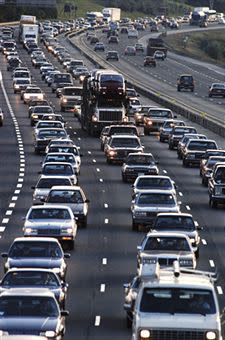 Daily Brew
Daily BrewEdmonton first North American city to test automated ‘smart’ highway to ease gridlock
As someone who last week spent more than an hour creeping down Toronto's notorious Highway 401 "freeway" at walking speed for no obvious reason, Edmonton's ambitious smart highway experiment is worth attention.
The Alberta capital is putting the finishing touches on a system that wires up the Yellowhead Trail, the city's major east-west corridor, the Edmonton Journal reports.
"Imagine a world where the road itself can sense how many cars are rolling down it at any one time, where computers sense a collision, warn drivers and change traffic signals to get everyone on their way again faster, all without human help," writes reporter Elise Stolte.
Edmonton signed up to be a test site with PTV, a German traffic logistics firm, automaker BMW and other companies.
"This will be the first in North America, no question about it," Thomas Bauer, chief operations officer for Mygistics, a subsidiary of PTV based in Portland, Ore., told the Journal.
Yellowhead Trail is a major corridor for commercial vehicles, making up 13 per cent of the artery's 70,000 vehicles a day. Last year, it averaged two crashes a day and a total of three deaths.
The push for improving traffic-management technology began in 1999 after a new transportation plan ruled out expanding roads inside the city.
"It's about cost," said Brice Stephenson, the city's manager of transportation operations. "If you wanted to upgrade a road like the Yellowhead to a freeway, it would be very expensive, hundreds of millions of dollars."
By contrast, the tab for smart-road technology, including cameras, new traffic signals, road sensors and digital signs, is about $10 million.
The program includes upgrading road sensors that control traffic signals on the Yellowhead. New sensors are sensitive enough to measure not only vehicle volume but speed and size tell the difference between trucks and cars.
Finally, 28 permanent message boards are being added to provide warnings about ice or lane closures.
For now the system is controlled from the city's 16th-floor traffic command centre but the goal is to turn it over to a computer, says traffic technician Wai Cheung. The automated system will roll out slowly to ensure the computerized system is reliable.
Cheung is working on the last piece of the puzzle, the software that can take the sensor data, analyze it and make traffic adjustments. Mygistics is completing tests and Cheung expects to have it in his hands soon.
"When the system is fully working, the computer will receive an automatically generated signal from the road or video camera, then calculate the best place to detour drivers," the Journal reports. "It will post a message on digital signs above the Yellowhead. Then it will predict what congestion that detour route will cause on side roads, and change the traffic signals there to get everyone moving better."
The ultimate goal is personalized route mapping based on real-time congestion, the paper says.
Partner BMW hopes the system will feed information into drivers' personal navigation systems to give them the best routes possible to avoid conjestion.
(Getty Images)


